Acute immune response to Mycobacterium massiliense in C57BL/6 and BALB/c mice
- PMID: 20123718
- PMCID: PMC2849394
- DOI: 10.1128/IAI.00731-09
Acute immune response to Mycobacterium massiliense in C57BL/6 and BALB/c mice
Abstract
Mycobacterium massiliense is an environmental opportunistic pathogen that has been associated with soft tissue infection after minor surgery. We studied the acute immune response of C57BL/6 and BALB/c mice infected intravenously with 10(6) CFU of an M. massiliense strain isolated from a nosocomial infection in Brazil. The results presented here show that M. massiliense is virulent and pathogenic to both C57BL/6 and BALB/c mice, inducing a granulomatous inflammatory reaction that involves the activation of macrophages, dendritic cells, and natural killer cells induced by gamma interferon and interleukin-17 (IL-17) in C57BL/6 mice and by IL-12 in BALB/c mice.
Figures
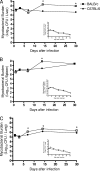
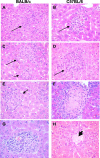
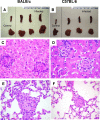


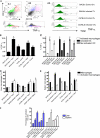
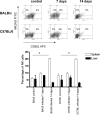
Similar articles
-
Mycobacterium genavense infection in normal and immunodeficient mice.Microbes Infect. 2000 May;2(6):575-80. doi: 10.1016/s1286-4579(00)00369-5. Microbes Infect. 2000. PMID: 10884607
-
Importance of T cells, gamma interferon, and tumor necrosis factor in immune control of the rapid grower Mycobacterium abscessus in C57BL/6 mice.Infect Immun. 2007 Dec;75(12):5898-907. doi: 10.1128/IAI.00014-07. Epub 2007 Sep 17. Infect Immun. 2007. PMID: 17875636 Free PMC article.
-
Inflammatory dendritic cells migrate in and out of transplanted chronic mycobacterial granulomas in mice.J Clin Invest. 2011 Oct;121(10):3902-13. doi: 10.1172/JCI45113. Epub 2011 Sep 12. J Clin Invest. 2011. PMID: 21911937 Free PMC article.
-
The many niches and strategies used by pathogenic mycobacteria for survival within host macrophages.Immunobiology. 2009;214(7):526-42. doi: 10.1016/j.imbio.2008.12.005. Epub 2009 Mar 3. Immunobiology. 2009. PMID: 19261352 Review.
-
Monocyte-derived inflammatory dendritic cells in the granuloma during mycobacterial infection.Adv Exp Med Biol. 2012;946:277-93. doi: 10.1007/978-1-4614-0106-3_16. Adv Exp Med Biol. 2012. PMID: 21948374 Review.
Cited by
-
The mycma_1113 Gene from Mycobacterium abscessus subsp. massiliense is Related to Siderophore Synthesis.Indian J Microbiol. 2019 Jun;59(2):180-187. doi: 10.1007/s12088-019-00788-z. Epub 2019 Feb 27. Indian J Microbiol. 2019. PMID: 31031432 Free PMC article.
-
Mycobacterium abscessus subsp. massiliense: Biofilm Formation, Host Immune Response, and Therapeutic Strategies.Microorganisms. 2025 Feb 18;13(2):447. doi: 10.3390/microorganisms13020447. Microorganisms. 2025. PMID: 40005812 Free PMC article. Review.
-
Increased virulence of an epidemic strain of Mycobacterium massiliense in mice.PLoS One. 2011;6(9):e24726. doi: 10.1371/journal.pone.0024726. Epub 2011 Sep 12. PLoS One. 2011. PMID: 21931831 Free PMC article.
-
Non-disulfide-Bridge Peptide 5.5 from the Scorpion Hadrurus gertschi Inhibits the Growth of Mycobacterium abscessus subsp. massiliense.Front Microbiol. 2017 Feb 22;8:273. doi: 10.3389/fmicb.2017.00273. eCollection 2017. Front Microbiol. 2017. PMID: 28275372 Free PMC article.
-
Antimycobacterial Activity of a New Peptide Polydim-I Isolated from Neotropical Social Wasp Polybia dimorpha.PLoS One. 2016 Mar 1;11(3):e0149729. doi: 10.1371/journal.pone.0149729. eCollection 2016. PLoS One. 2016. PMID: 26930596 Free PMC article.
References
-
- Cardona, P. J., A. Cooper, M. Luqui, A. A. Filipos, I. M. Orme, and V. Ausuna. 1999. The intravenous model of murine tuberculosis is less pathogenic than the aerogenic model owing to a more rapid induction of systemic immunity. Scand. J. Immunol. 49:362-366. - PubMed
-
- Cardoso, A. M., E. M. de Sousa, C. Viana-Niero, F. B. de Bortoli, Z. C. P. das Neves, S. C. Leão, A. P. Junqueira-Kipnis, and A. Kipnis. 2008. Emergence of nosocomial Mycobacterium massiliense infection in Goiás, Brazil. Microbes Infect. 10:1552-1557. - PubMed
Publication types
MeSH terms
Substances
LinkOut - more resources
Full Text Sources
Medical

